In March 2013, I met David Grann for the first time, in his office at The New Yorker. We were there ostensibly to discuss his adroit use of Twitter, but first he wanted to talk about something else: a book project. It was, he said, about how, in early 1920s, swaths of the Osage Nation, in Oklahoma, were systematically slaughtered. These invariably brutal killings eventually fell under the jurisdiction of J. Edgar Hoover’s nascent Bureau of Investigation.
It was only in recent weeks, Grann said, that the contours of the untitled project — which the publishing house hadn’t bothered to announce — had come into focus. The trouble was, for the better part of a year, he’d been buried in documents; wills, testaments, court records. In other words, the fruits of FOIA. “Often what I was finding seemed so boring,” he said, as we sat in that cramped office. “I hope there’s enough there.”
The book’s broad outline, in the form of a character tree, leaned against his desk. On a massive piece of cardboard was scrawled on “OSAGE” on one side, “INVESTIGATORS” on the other, and dozens of names underneath.
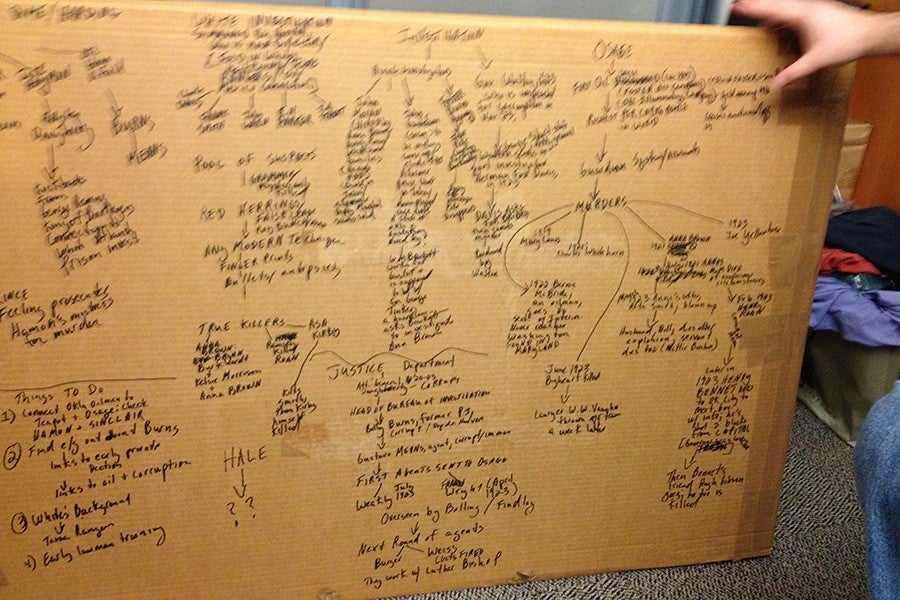
Then Grann said something that shocked me, because he was so casual about it.
“I think I’ve solved one of the murders,” he said.
Really?
“Yeah, circumstantial.”
But it was obvious he had no doubt.
The book, which wouldn’t have a title for another year, was Killers of the Flower Moon: The Osage Murders and the Birth of the FBI. It would be another three years before it was optioned for a sum that could be fairly described as generous. But, even then, it was clear how good Grann’s book would be.
I got lucky. After I interviewed Grann, we became friends. I watched Killers of the Flower Moon progress. Not long ago, I found an old email from him with potential book titles; of the ones that didn’t make it, “The Killer Moon” and “The Killers and the Evidence Men” are my favorites.
I mention this, in part, because I am in no way a disinterested observer. (I’m in the damn acknowledgements.) But Killers of the Flower Moon, I’m happy to say, has more than fulfilled its embryonic promise. David and I talked about it last month.

So: How did this come about?
A historian had mentioned this story to me in 2011. At that point, I found that no one had done a full-length investigative history of it all.
In 2012, I went out to Oklahoma for the first time. When I visited the Osage Nation Museum, there was this big panoramic photograph on the wall; it showed the Osage and white settlers. It was taken in 1924. Part of the photograph was cut out, and pieces were missing. I asked the museum director, a lovely woman named Kathryn Red Corn, about the missing section. It was too painful to look at, she said. Pointing to the gap in the photo, she said, The Devil was standing right there.
Kathryn retrieved the missing panel from the basement. What had been cut out was the Devil himself — a mastermind of the conspiracy to kill the Osage for their oil.
I’d gone out to Oklahoma to get a sense of the story, to see if I’d even want to tell it. And that photo was, for me, a turning point. I really wanted to know who the hell that devil was. I wanted to understand the story that the Osage could not and would not forget. And I wanted to understand why the hell all the rest of the country had no memory of it. I had never read about the murders in school. I’d never been told about them. With every story there’s a moment where you decide, Okay, this is a story I really want to tell. This was that moment.
What was the next step?
I had no idea if I could tell the story. I mean, these crimes took place in the 1920s and earlier. Reporters and historians are limited by the available materials. So I came back to New York. I’d already begun to file Freedom of Information Act requests, and I wrote letters to every institution that might’ve been involved in the case or have records. I wrote to every local courthouse that might have held trials. I wrote to every sheriff’s office in different counties. I did FOIAs for the FBI; multiple FOIAs for every individual involved; FOIAs for personal records of all the agents; FOIAs for anything for anything Hoover-related; FOIAs for the Department of the Interior and the Bureau of Indian Affairs.
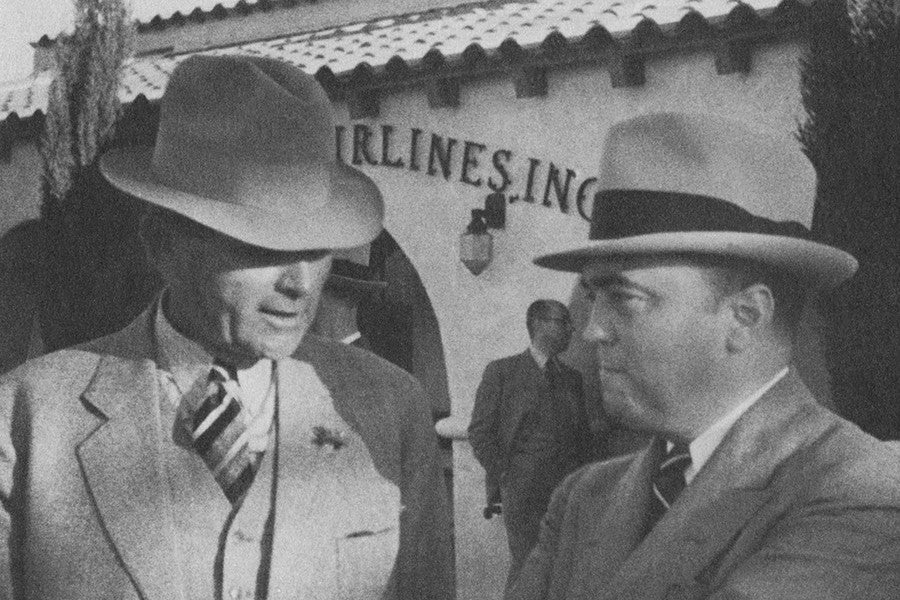
Once that was done, I went back to work at my regular job at The New Yorker. I waited for materials. Over a span of about a year, they trickled in — sometimes every couple weeks, sometimes every month. Sometimes there would be just a letter saying, We have nothing. I didn’t look at any of it, because I was busy working on other stuff. I literally put it all in the corner. Then, after a year, I looked at the material. And as I sifted through it, I could see a clear trail. There were records, accounts, testimony. It was probably, at most, 20 percent of the research that ultimately went into the book. But it was enough to give me the confidence to find the other 80 percent.
What were the particular challenges of this project?
With Z, I humped through the Amazon, dealt with some physical dangers and certainly a hell of a lot of physical discomfort; I hate the jungle and hate camping. But in many ways, that was so much easier, because the challenge was purely physical. With this book, the challenge was mental: to get ahold of vast amounts of material, spread across different archives, and to track down the descendants of the long-dead and get their stories.
I had difficulty. I say all that because I don’t like to mythologize. Reporters have a tendency to mythologize what we do. There’s some romantic vision that we’re living in All the President’s Men. I always hate to do that. I mean, what we do is great, and it’s fortunate. But in some ways it’s pretty mundane. It’s going to archives and looking for materials. It’s not sexy or anything.
There’s a scene of funeral where you note “the sound of the earth clapping against the lid.” It’s a wonderful detail because it’s so mundane; it wouldn’t be mentioned in a news report or even a diary. Where did you get that detail?
I spoke to one of Mollie Burkhart’s descendants, who was alive at the time [of the murders]. Even though she was a little girl, she shared with me what she knew from her family about the funeral. Another descendent described something I didn’t put in the story: how some of the kids walked across the grave during the funeral of Henry Roan, which I guess was something they did at the time. She was able to give me these little intimate details about that process. That kind of haunted me. I was also able to get other details from the testimony of the funeral director who attended the funerals and was interviewed multiple times by investigators.
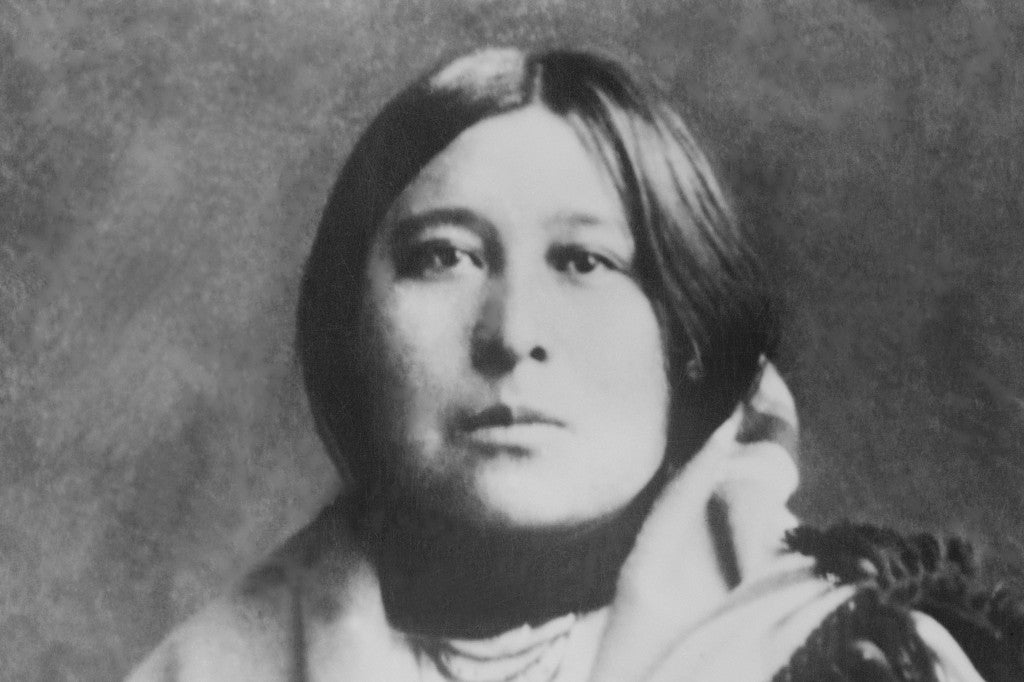
The structure — three sections, each from a different narrative perspective — is unusual for nonfiction. How did you settle on it?
When I got the materials, I knew there was a story there, but the materials were so clinical. It was a jumble of lawmen, investigations, victims and suspected killers. I had no idea what to do with this. I was really bewildered. But then in June 2012, I read a story by John Jeremiah Sullivan, whose work I love. He’d written about Faulkner’s Absalom, Absalom! And, because I am a person who feels guilty about all the gaps in my education, I immediately read the remarkable book. It had, basically, three narrators. It had a kind of oral history quality. It’s fiction, of course, and the language is different. But you don’t ever know how your brain works; you are constantly being influenced.
It was a subtle influence, you know; the brain is a weird thing. I thought, Well, what if I tell the story from the point of view of Mollie, an Osage woman who is the prime target of the conspiracy? I wanted it to be an Osage story. I didn’t want it to be some conventional Western where the white man shows up as some kind of savior. And then I needed to pick one agent, because there were dozens of investigators involved and concurrent Bureau investigations. Tom White would help lead me through that story.
It sounds like the structure kept you sane.
The structure totally kept me sane. I could not control the material. I was overwhelmed. But the structure also, I hope, allows the reader to experience what’s happening through Mollie and Tom. It’s not a postmodern book. I am not a postmodernist. I am a deep believer in facts, and that if somebody is shot in a room, there will be a dead body. These are crimes that happened, and there was one perpetrator, or two. Something happened. But there are difficulties in trying to get to the truth and to show it. The truth can be slippery and hard to find.
I think it’s even harder for people experiencing history to always know what is happening. We have a tendency to look back in hindsight, but none of us go through life that way. We never know what the answer is to our own lives, let alone a huge conspiracy that’s unfolding around us. The structure hopefully allowed the reader to experience it as the FBI and the Osage did, as history unfolded, and as they struggled to make sense of events. They could see many things, but they couldn’t always see everything.
Each person in the story has only limited knowledge, as we all do. We can only see so much. We have blinders, biases. None of us are Sherlock Holmes. So with the third chronicle, which is from my perspective, I realized I could bring the reader up to present, and fill in the narrative gaps.
Yeah, one surprise of the book is how much you’re actually in it.
I learned, over the course of my research, that the conspiracy was much deeper and much wider that had generally been assumed. Many Osage gave me evidence, or trails to other cases that I began to chase. I wanted to hopefully bring as much accounting to these cases as I could. Of course, in many cases I found that I was chasing ghosts. That’s why the book took so long to do. I was chasing these trails, hoping to bring some accounting. History can’t bring justice to cases where murderers went free and the victims’ stories weren’t told. What you want is an accounting, for the victims’ stories to be recorded, and for the perpetrators to be named and identified for posterity.
In some cases, I was able to do this, I think, and identify a new killer. But there were other cases where I was no different than any of the characters who I wrote about; we are trapped in our limited knowledge in the events. It’s not that the truth doesn’t exist, it’s just that we can’t always see it all. I’d always thought that the horror of a crime is what you know, right? That when you write about a crime, and you write about a racial injustice, the horror is what you know. But I also realized that, in fact, the greater horror may be what you don’t know, and what can no longer be accounted for.
How much did the Osage Nation know about the murders?
We’re talking now, in most cases, three generations removed from the crimes. And yet, for the Osage, history wasn’t relegated to the past. I met a wonderful woman named Mary Jo Webb, who was in her 80s. She was a respected Osage elder. Webb had a box with documents. She’d spent decades collecting information, trying to get to the bottom of the murders. She had enormous evidence. But she and the tribe had lived with these ghosts and tragedies for a hundred years, and had never stopped looking for answers, looking for justice. She had court records, wills, testimonials. She had been her own private investigator.
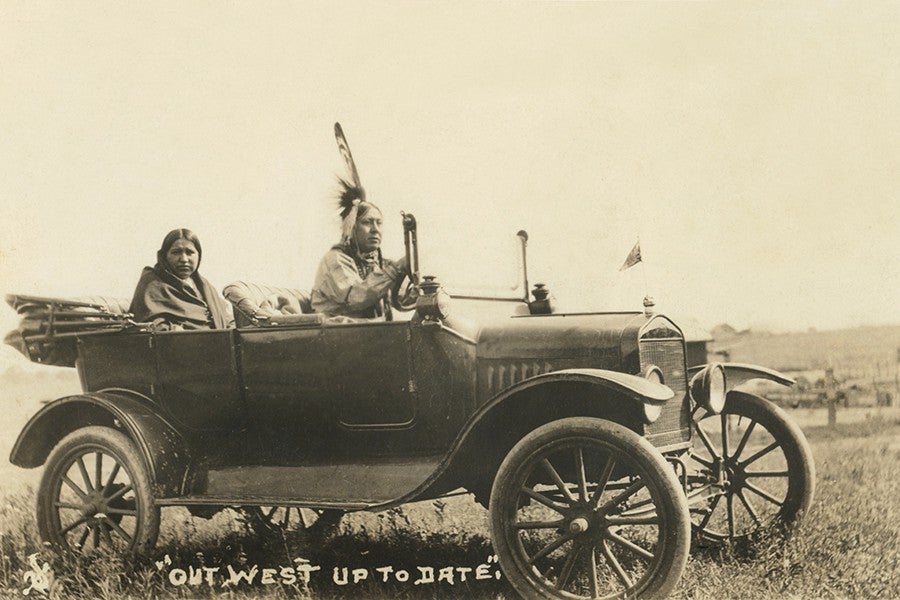
Some of the families believed they had identified their killers. But many didn’t, and they lived with doubt and lived with suspicion about the perpetrators.
It sounds like they were pretty knowledgeable.
What is consistent is how much they live with this history, and how much, absent a full accounting, this history still lives. There was justice in some cases, but not many.
There’s a non-Osage family named Vaughan. W.W. Vaughan was a local attorney. He was very close to the Osage and tried to stop the killers. He gathered information. At one point, he thought he had gathered enough evidence. He was in Oklahoma City, where he had met with an Osage man who had been poisoned. After the Osage died, and apparently gave him documents, Vaughan called the local sheriff’s office and said, I’ve got the information. I’ve got them. He didn’t say who’d done it.
He boarded a train for Osage County, and he never showed up. Bloodhounds were sent to find him. Boy Scouts took up the chase, too. Eventually, his body was found stripped and naked by the railroad tracks; he’d been thrown off the train and his neck broken. Any documents on his person had been taken from him, and documents he had left in a safe had been removed.
Did Vaughan’s descendants have anything useful?
Among others, I was able to track down Martha Vaughan, the granddaughter. She had gathered a few clues, but had no idea who ultimately had thrown her grandfather off the train. But she’d given me one name of somebody with whom her mom had some friction. So I started with that, and I spent a long time researching that case. In the end, I think I’d gathered enough evidence to identify the killer. I say that with the proviso that you can’t know with 100 percent certainty. You’re looking at cases from long ago. The perpetrator can’t speak for himself. I always want to be cognizant of that, and respectful of that. But, I do think I gathered a fair amount of circumstantial and direct evidence to link him to Vaughan’s murder.
I called Martha up to tell her. Her family had suffered greatly from this. Vaughan had 10 children. He was a pretty wealthy, successful lawyer, and suddenly the money was gone. They were terrified. The Osage took many of the kids in and raised them. They grew up speaking Osage, and going to Osage dances. The Osage protected the Vaughan kids, because they, too, were targets.
Anyway, as I told Martha what I had found, and reviewed the evidence, she began to cry. I said, I’m so sorry. I felt bad about sharing this. No, no, no, she said, we’ve been living with this [the mystery surrounding Vaughn’s death] for so long to know the answers.
Two of the scariest characters in the book, perhaps because they aren’t fully realized, are the Shoun brothers.
There are, and it raises a larger issue. There are all these characters who are part of this story: morticians, bankers, doctors, and various settlers, local reporters and whatnot, and other white people who live in the community. These people hover on the edges of the story. They were not primarily investigated. Indeed, they are in many ways not fully realized. What I wanted to convey, at least in some cases, was the complicity by so many people in these crimes.
In some ways, the story has the natural structure of a mystery story; the case is, to some degree, solved, and a singular villain was arrested. And this was a man of truly Biblical evil. But there also were willing executioners. Sometimes they participated in the crime, sometimes they profited directly, sometimes they turned a blind eye. So your observation gets to that: these are people about whom you can only tell so much, because they were never primary targets of the investigation. But you begin to realize,Oh my God, they certainly seemed to have their hands involved.
This really was a massive conspiracy.
There was a conspiracy within the power structure. And there was a culture of complicity, a culture of killing. All stories have revelations, and this story has so many weird, surprising twists and turns in solving the case, and who was behind it, and how intimate these crimes were. But the most shocking revelation is the complicity of all these apparently ordinary figures who seem to come in and out of the story.
Look: This was, in a way, a little town. These people all knew each other; they were supposed to be looking after each other. The degree to which some of the white people systematically and conspiratorially murdered their neighbors is mind-boggling.
As a white man, were you concerned about chronicling a history so removed from your own?
Any time you’re reporting on people’s stories, there should be a sensitivity. When you’re writing about a racial injustice, you should be even more attuned to the issues. When I went out and spent time with the Osage, they were extremely helpful and generous, and many of the descendants wanted this story told. They shared their stories, and gave me the evidence they had gathered, and gave me trails to search down. And, over time, they become part of the process. I hope, with their help, I did the story justice.
To what extent did the Osage talk to you because they wanted their story told versus them being fans of your work?
Nobody knew who I was. I had originally called a lovely man named Charles Red Corn, who is one of the Osage elders. He had written a beautiful novel called A Pipe for February, which deals with some of these events of the Osage Reign of Terror. I said I was hoping to come out. He met me, and helped introduce me to people. That began the process.
When you’re reporting, you need to spend time with people, and you need people to feel comfortable with you. That’s always a process. But, like I said, the Osage were — I’m hesitating, because I hate to speak for other people, you know? I didn’t ever ask them, Why are you talking to me? But I do think there was a collective sense that this history had been largely forgotten by the rest of the country, if it was ever even known. The Osage know their history intimately, and are understandably upset that it has been excised from our broader American narrative. Of course, in several cases, they had cases they personally wanted investigated, and would give me trails of evidence in the hope that I could find answers.
What did Osage Nation think of the book? I ask because there’s sometimes a feeling among journalists that when the story’s done, the story’s done, and you try not to think about how the subjects feel about it.
You always think about it. Reporting and writing is a great blessing, because you get to go out in the world, you get to meet people, you get to hear people’s stories. You get to learn. You’re constantly on a journey of learning. But you’re also taking people’s stories, and trying to tell them as faithfully as possible. That’s true in any story I write. And it’s a difficult thing because, as a reporter and writer, your ultimate bond is to the truth, wherever that takes you.
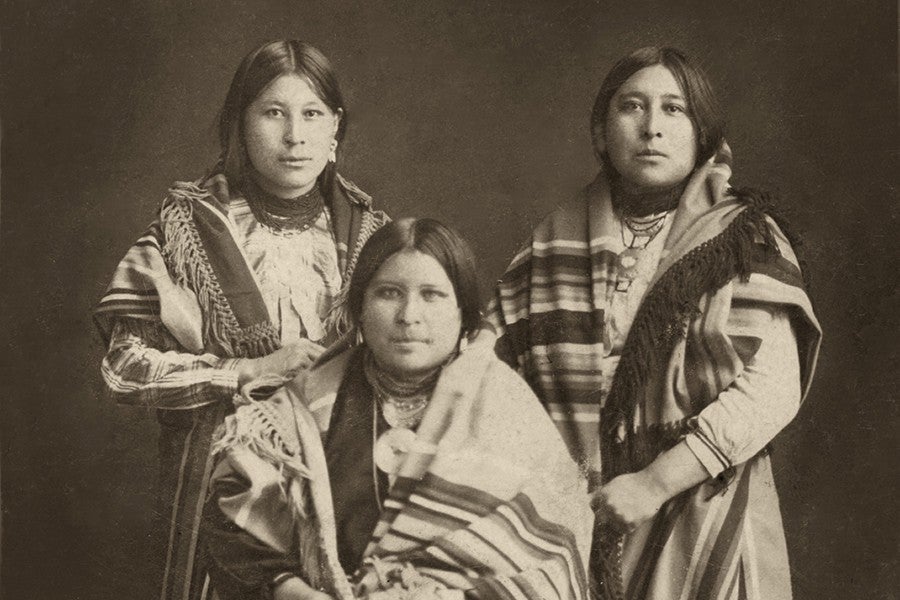
In a case like this, there may be some descendants of some of the murderers, including people I’ve identified by name, who are not going to be happy. Some of these descendants have even remained in the area. But your responsibility to any story is to do it as faithfully and as sensitively as possible, even if it makes people uncomfortable.
Did any descendants of the murderers talk to you?
Yes. What was interesting was how honest they were. Most of them were candid about what they knew, at least in this particular family. They did not deny things. They didn’t necessarily know the breadth of everything.
I got a surprising note from a descendant. He said he was the last male in the family chain of his murderous progenitor, and he expressed deep remorse for what his ancestors had done. He asked me if, when I met with the Osage, I would pass along his remorse. I was quite struck by that.
When we first talked about this book in March 2013, you’d written 1,000 words. How did you think this project would play out?
I knew it would be difficult. I always say this, as a proviso: In our business, you get no points for difficulty. The work can be just as good if it’s easy — if somebody calls you up and gives you a great scoop — as if you spend five years trying to get the material to tell it. Killers of the Flower Moon was hard because it was so historical. It was, in many ways, the first pure piece of history I’ve done.
It’s the story of an incredibly sinister crime — a true racial injustice. I did not want this to be simply a cataloging of the dead. And I didn’t want it to be cursory. For the most part, when these murders had been written about — if they were mentioned at all — there was no sense of who these people were, or what their lives were like. You never got close to their consciousness or their souls. That’s what I set out to do.
